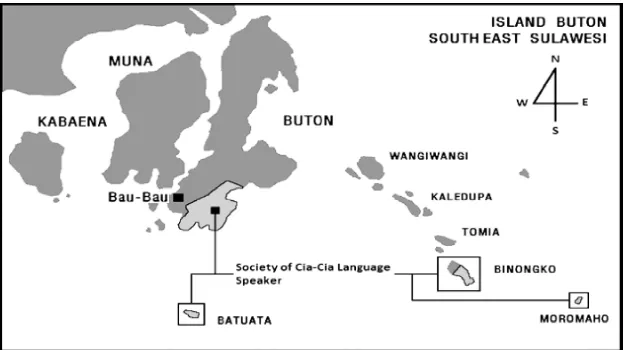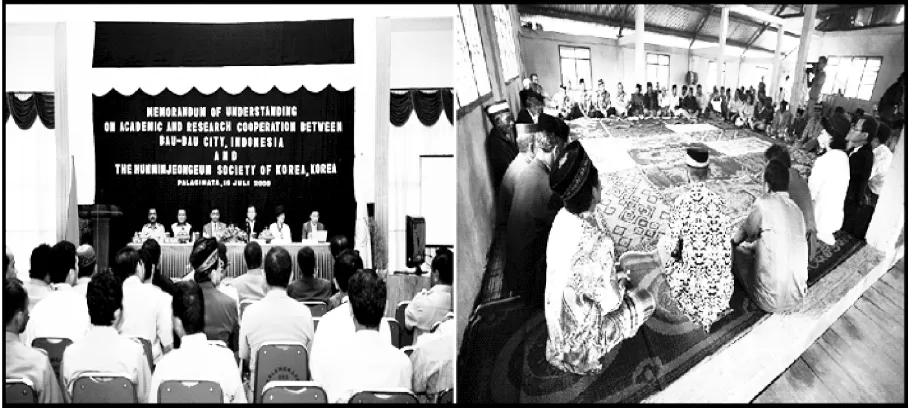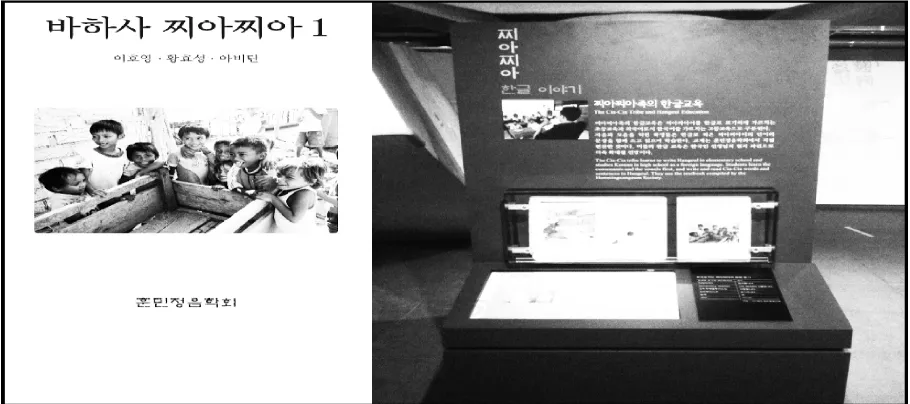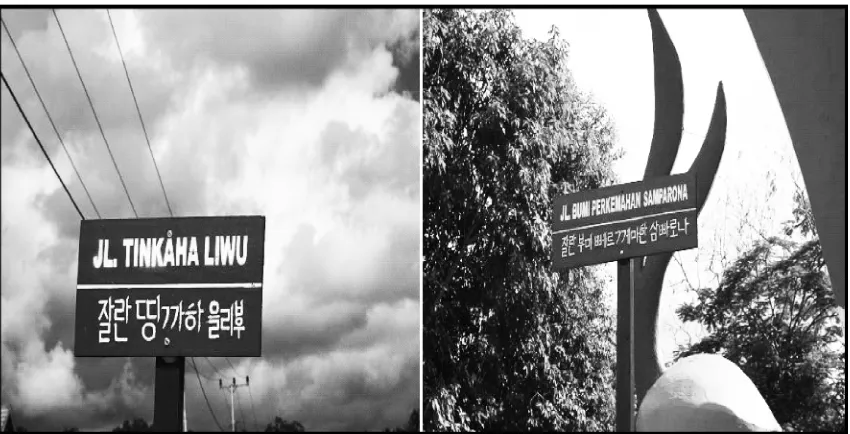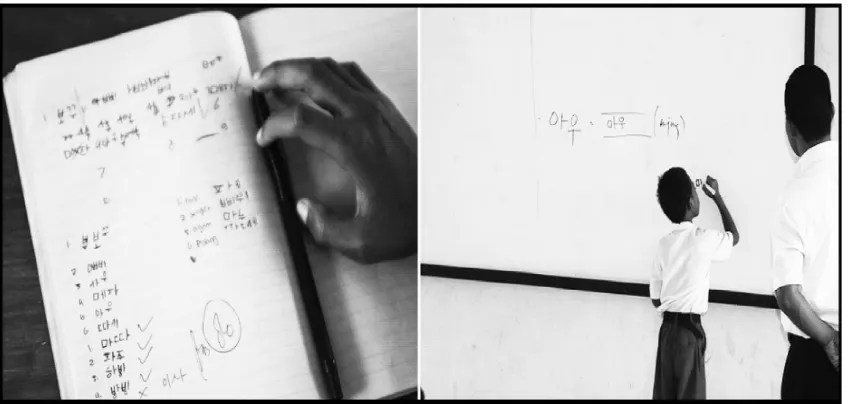VOLUME 24 No. 3 Oktober 2012 Halaman 324 - 332
* Institute for East Asian Studies, Sogang University, South Korea
CIA-CIA LANGUAGE: FROM THE ERA OF ORAL
TO THE ERA OF WRITING
Cho, Tae-Young*
ABSTRAK
Tulisan ini bertujuan mendeskripsikan latar belakang penerimaan dan penggunaan Hangeul (sistem tulisan Korea) di masyarakat penutur bahasa Cia-Cia sebagai sistem tulisan mereka yang dimulai pelaksanaannya pada bulan Juli 2009. Peristiwa ini sangat mengagetkan, baik seluruh masyarakat Indonesia maupun negara-negara tetangga karena aksara Latin sedang memegang peranan kuat dalam penggunaan aksara di seluruh dunia pada zaman ini. Dari sisi yang lain, yakni aspek sejarah perkembangan aksara di dunia ini yang berjalan dalam proses peminjaman dan penyesuaian aksara secara berulang terus membuktikan bahwa suatu sistem tulisan (selain Latin) juga dapat digunakan dalam masyarakat bahasa yang lain pada abad ke-21. Seperti sejumlah besar masyarakat bahasa minoritas, masyarakat bahasa Cia-Cia pun belum pernah memiliki sistem tulisan tersendiri sehingga bahasanya tidak pernah sekali pun dituliskan dengan aksara apapun. Penulisan Hangeul dalam bahasa Cia-Cia dimulai dengan maksud untuk melestarikan bahasa minoritas. Sesuai dengan maksud tersebut, jika kelangsungan hidup bahasa Cia-Cia akan dilanjutkan dengan stabil, Hangeul akan diingat sebagai salah satu sistem tulisan yang telah melestarikan bahasa Cia-Cia dalam sejarah perkembangan aksara di dunia ini.
Kata Kunci: Bahasa Cia-Cia, bahasa minoritas, Hangeul, peminjaman aksara
ABSTRACT
This paper aimed to describe the background of Cia-Cia language society’s adoption and use of Hangeul (Korean alphabet) as its writing system that was begun in July 2009. The issue has caused Indonesian society and neighborhood countries curious, since Latin alphabet is world widely used as the most common writing system at present time. On the other side, the historical background of writing system’s development which has been implemented sustainably through borrowing and adapting process proves that any writing system can also be used in other language society in the 21st century. Similar to that of the most of minority language societies, Cia-Cia language has not had its own writing system. The transcription of Hangeul in Cia-Cia language was begun to support the preservation of minority language. Concern to this issue, if the spoken language of Cia-Cia is stabilly continued, Hangeul will be known as one of the writing systems which has preserved Cia-Cia language in world’s development of writing system history.
INTRODUCTION
Linguists estimate that there are 6,700 types of languages across the globe (Nettle & Romaine,
2000:21). If the types of languages are compared to 230 countries around the world, it can be concluded that more than one country uses more than one language. Most of countries across the globe are multilingual societies. Differ from type of language, writing system can only be found in small number than the spoken language. Writings that have been used in the world are noted about 28-30. It is simply described that one writing system plays its role to several particular languages.
In European continent, North/SouthAmerica, and other European collonialization, people use Latin alphabet as their writing system. In several countries that are influenced by Islamic culture, they use Arabic writing system. In East Asian countries such as Korea and Japan, Chinese character is remain used eventhough the two countries have their own writing system. Such circumstances can lead an understanding that there are still many languages do not have their own writing system in recording their spoken languages. In other words, some nations may continue their civilization without using one single writing system.
Gelb who conductedresearch on writing system, the-so-calledGrammatologyexplained that Writing exists only in a civilization and a civilization cannot exist without writing
(Gelb,1952:v, 222). Writing is tightly related to human civilization in all aspects of life. Based on Gelbs’ idea, can we conclude a nation with no writing has already built its own civilization? This question is rarely taken seriously, however the occurance of writing in a language society is fully related to its own civilization.The issue can be explored from history-of-writing point of view. Most of linguists agreed that the history of writing based on borrowing and adapting process done continually among nations. During the process, writing is more developed both genealogically and typologically.
Every society desires to descend and preserve its own oral tradition as a part of cultures.
People produce their own oral tradition in order to stay alive. Toward this process, borrowing-writing can be taken in particular society. The adaptation then plays an important role based on local culture and inhabitants. Generally, neighbourhood nations will apply same writing in several variations. It is due to the issue of geographicrange and similar civilization among them. Therefore, the role of human being is significantly important as the utterer, the active speaker.These whole processes are done by human being in order to record and preserve their oral tradition by using foreign writing after adaptation process.
Indonesiais widely-known as a country which has been using different types of writings (includes nearly-extinct ones). These all writings are borrowed from foreign civilization. Hardiati groups Indonesian writings into three main foreign civilization, they are Indian, Arabic, and Latin (Hardiati, 2002:2-3). All writings have adapted based on Indonesian local language and culture. Pallawa, Kawi, Sunda, Bali, Batak, Kerinci, Lontarak, Jawi, Pégon, Sérang, and Wolio are the result of borrowing-adapting process from India andArabic writings, in order to preserve oral tradition in Indonesia.The occurance of these writings can be seen as reflection of a long history of writing development. However, in Indonesia alone there are a lot of ethnics which have not been in touch with the importance of writing and its long-inhabitted history.
understand-ingtoward the history of Buton Island in the current situation, due to the implementation of Hangeul.
CIA-CIA LANGUAGE SOCIETY
‘Bhinneka Tunggal Ika’ (Unity in Diversity) as Indonesian national slogan declares diversity of ethnic, religion, language, and other cultural aspect that are all unite in Indonesia (KBBI, 1988:112). Taking a look of this slogan, Indonesia has variety and huge numbers of ethnics with their own language and culture. Based on SIL data, Indonesia has 731 existing languages (SIL, 2001:1). This number of language can be also concluded as the number of ethnics across Indonesian archipelago.
Among different ethnic groups, Cia-Cia whose name derived from the word‘cia (meaning no)’in Cia-Cia language and its dialects situated in Buton Island, Southeast Sulawesi (Hamzah Lajura creates the name ‘Cia-Cia’, Mustafa, 1991:7).Cia-Cia is one of the languages spoken in Buton Island, outsideneighbor languages are Wolio, Muna and Liabuku.Cia-Cia is using by 79,000 peopleliving in Southern of Buton Island as shows below (Based on SIL data in 2005 year, there are 79,000 Cia-Cia language native speakers). Buton Island, Cia-Cia language utterer can be found in Batuata Island, Binongko Island and Moromaho Island as the native homes. Makassar, Kendari, even Maluku are also some home for minority Cia-Cia people.
Unlike other ethnic groups in Indonesia, Cia-Cia has never experiences using of any writing system. The utterer have not been intouch with any particular writing such as Wolio, Lontarak, or Sérang, which have been used by neighborhood ethnic groups, Buginese and Makasarese of Buton. However, Cia-Cia still has its own oral tradition, expreeses in its spoken language without any particular writing. Cia-Cia language society is one of the parts of Indonesia who is actively utter Indonesian language written in Latin alphabet. Hence, they symbolize their spoken language in Latin.
From the minority point of view, Cia-Cia society does not have one single writing system that can represent the exact sound of their spoken language into written text. Therefore, they never record any of their oral tradition in written text. In this terribly circumstance, Cia-Cia society needs to struggle in preserving their nearly-extinct-language. Cia-Cia spoken language is not actively uttered by their own young generation. On the 2007 National Symposium of Indonesian Language, Jusuf Kalla mentioned for the past 20 years of time, 30% of Indonesian local language-shave fallen to extinction (Tamim, 2010:27 requoted by Chun Tai-Hyun, 2010b:182).The number pottentially increases in the upcoming future, specifically languages without their own writing systems.
FROM HANGEUL TO CIA-CIA WRITING
If a new writing system occurs, then it must be influenced by the existing ones. All writing systems are developed and are influenced from the existing to the current one. Indeed, the system of writing can develop genealogically and typhologically. The history of writing system development is an established theory for all linguists. However, Hangeul, Korean writing is not yet included in the history. Hangeul is derived from two words ‘han’ and ‘geul’. The word 'han' means nation or Korea, while ‘geul’ refers to word, alphabet, and script. Therefore, Hangeul means the alphabet of Korea, or Korean writing system. Hangeul is known as the one and only writing system that is intentionally created by human (King Sejong the Great). King Sejong the Great (1397-1450) was the 4th King of Joseon
dinasty (1392-1897), Korea. King Sejong was not only famous as a King, but also a scholar in different field of knowledges. In his reign, Korea has no own writing system and was influenced by Chinese character. Korean people struggled in communicating their ideas into words and writing, since Chinese alphabet could not fully symbolize Korean phonic system. Therefore, King Sejong the Great created Hangeul along with several language experts in 1443.Three years after, exactly in 1446, King Sejong the Great announced Hangeul as the official writing of Joseon dinasty. Further information about Hangeul background can be referred on (Kang Shin-Hang, Kim Ju-Won, Shin Sang-Soon & Lee Sang-Oak, 2008).
Hunminjeongeum (means ‘the right sounds to teach illiterate people’) that includes the teaching of Hangeul and its historical background, King Sejong the Great declared,
Korean language,the phonic system is far different to Chinese. Therefore, Korean has been strunggling to communicate their ideas in Chinese character. The creation of the 28 alphabets aims at overcoming Korean people difficulties in learning and writing in conducting daily activities… Hangeul is easy to learn in a day for the quick learner, or ten days at the
latest… This Hangeul can properly symbolize variety sounds of animals and nature (Translated by writer from Kang Shin-Hang, Kim Ju-Won, Shin Sang-Soon & Lee Sang-Oak, 2008: 91, 113-114).
It explains Hangeul as an intentionally created alphabet by King Sejong the Great in order to symbolize phonemic-based writing system, also to overcome Korean struggling and difficulties in communicating in daily life. Several linguists of
Grammatologyfield agreed that Hangeul is the only scientifically writing system in the world which is intentionally created. Fisher declared that Korean writing system is not taken from borrowing-adapting process as other writing systems had experienced. It is, on the contrary, an intentionally created writing system containing clear purposes. Another linguist,Sampsonexamines Hangeul as one of the highest achievements in human civilization (Fischer, 2010: 256 requoted by Chun Tai-Hyun, 2010:189).
The introduction of Hangeul into Cia-cia language society was firstly doing by a Korean linguist Chun Tai-Hyun. As a professor in Malay-Indonesian language at Hankuk University of Foreign Studies(HUFS), he has dedicated his time in conducting researches toward Indonesian language along with several its local languages. Since 1980s, he had been visiting Eastern Indonesia. As an Indonesian language expert, he is fully corcern and aware with several ethnic groups who do not have their own writings. In 2005, an International Symposium of Indonesian Manuscripts held in Bau-Bau, Chun Tai-Hyun focused his concern to some ethnic groups in Bau-Bau, Buton Island.
Based on meeting result to implement Hangeul into one of ethnic groups in Bau-Bau, Hunminjeongeum society sent an official letter to the Mayor of Bau-Bau offering on building up cooperation in culture and education through Hangeul. The offer was taken warmingly by the Mayor and was continued by Chun Tai-Hyun as Hunminjeongeum society member to Bau-Bau. In July 2008, Hunminjeongeum society and Bau-Bau local government signed MoU in creating mutual understanding in culture and education. At the time, the Mayor Amirul Tamim suggested Cia-Cia language as one of the main local languages around Bau-Bau, which was happen-ed to not have its own writing system. Another meeting was held in Sorawolio, one of regencies in Bau-Bau where Cia-Cia native people live. The meeting resulted to an agreement of implement-ing Hangeul as Cia-Cia writimplement-ing system.
In December on the same year, two Cia-Cia elementary school teachers were invited to Korea in order to follow a language program atSeoul National University(SNU). However, one of them could not fully attend the language program after several weeks in Korea, due to lack of ability in adapting to Korean society. Abidin, an English teacher for elementary school in Bau-Bau was
Figure 2. MoU signing and meeting with Cia-Cia Ethnic Leader in Sorawolio (Lee Ho-Young, 2010)
successfully completed the language program at SNU and was finished Cia-Cia school book written in Hangeul with a phonetic professor Lee Ho-Young and his doctoral student Hwang Hyo-Sung.
Cia-Cia school book written in Hangeul was published on July 16th2009. The introduction of
Hangeul was officially begun at elementary school Karya Baru, Sorawolio, Bau-Bau on July 22nd2009. It was the first step of Cia-Cia writing
creation using Hangeul. The implementation of Hangeul into Cia-Cia language society becomes
Figure 3. School Book of Cia-Cia language and stand exhibition of Cia-Cia in Seoul (http://www.culturenomicsblog.seoul.go.kr/1146)
One year after, International Congress of Local Languages in South East Sulawesi was held in Bau-Bau on July 18-20, 2010, attended by linguists and language experts across the globe. Hangeul implementation in Cia-Cia language society was also presented and was becominghot issueduring the Congress. It was one year of Hangeul implementation.
THE USING OF CIA-CIA WRITING AND ITS FUTURE
As described above, worlds’ history of writing system development contains borrowing-adapting process that is done continuesly among nations. Latin alphabet, for instance, is used in almost all western countries with several variations and is derived from Phoenician writing. Such phenomenon is not only happened in European continent, but also in other areas. Countries that have experienced Islamic civilization will have Arabic as their writing along with its grapheme variation to local languages. These grapheme variation are different to one another, but are all derived from Arabic writing. In addition, Indian writing also had used by several ethnic groups in Indonesia such as Kawi, Batak, Lontarak, etc, which all have been adapting to local spoken languages.
The occurance of grapheme variation in borrowing-adapting writing process is seen as identity symbol of the recipient. In Cia-Cia writing, grapheme variation also occurs based on Cia-Cia phonic system. However, it is important to consider that these variations are not only occurring in Hangeul, but also in Cia-Cia writing. We can conclude that grapheme variation is an identity symbol of Cia-Cia writing in writing its own spoken language, not Korean. Therefore, Cia-Cia writing has qualification in playing its role as a writing system in symbolizing Cia-Cia spoken language.
In the past centuries, Humboldtdeclared Indonesian acceptance ability to foreign civilization as follow.
It describes not only the situation of Javanese society in accepting Indian civilization, but also all language societies in Indonesia toward foreign civilization. Therefore, several writing in Indonesia such as Pallawa, Kawi, Sunda, Bali, Batak, Kerinci, Lontarak, and Jawi, Pégon, Sérang, Wolio can be said as creative creation in order to preserve and to pass down their language and culture, though all is derived from writing system of foreign civilization (Chun Tai-Hyun, 1996: 358). Cia-Cia writing that is derived from Hangeul is a creative creation based on language system of Cia-Cia. It has grapheme variation to symbolize Cia-Cia language, not Korean.
Currently, street boards in Sorawolio are all written in two different alphabets, Latin and Cia-Cia. For other ethnic groups who visit this place, they will easily recognize Cia-Cia writing by looking at the street board.
Differ from children of other ethnic groups, Cia-Cia has the ability to read and write their writing. In Bau-Bau, there are classes of Cia-Cia writing at three different elementary schools; Karya Baru, Bugi I and Bugi II totaling 187 students
Figure 4. Street board written in Cia-Cia writing in Sorawolio, Bau-Bau
(Chun Tai-Hyun, 2010a: 1). When writer visited Bugi I in October 2010, the children were studying Cia-Cia language. They looked very excited in learning theirmother languageusing Cia-Cia writing. Such circumstance is far different than fact in Buginese-Makasarese language society in South Sulawesi, where children starting to forgot reading and writing Lontarak writing.
Figure 5. Class of Cia-Cia local language in Cia-Cia writing at elementary school Bugi I
CONCLUSION
One year of implementing Cia-Cia writing that is derived from Hangeul, Korean writing, controversy occurred among society in Indonesia and other countries. Question such ”Why Korean writing?” The motivation to write down Cia-Cia spoken languge into its own writing system is aiming to record and preserve their oral traditions. As research conducted in the beginning of the project resulting Hangeul is properly symbolizing Cia-Cia phenic system compare to other existing writing.
In Buginese-Makasarese society, South Sulawesi, there was an agreement in past times among kingdoms to keep their relation strong,
“…whoever found better way, he promises to tell (the better way) to other Kings”, (Sewang, 2005:112). Two Korean linguists, Chun Tai-Hyun and Lee Ho-Young after conducting their research, have suggested Hangeul as a better way to be implemented as Cia-Cia writing to record and preserve their spoken language.
In the upcoming future, the implementation of Cia-Cia writing is fully depending on their active utterer. However, a fascinating way to avoid the extinction of Cia-Cia spoken language has found by using Hangeul in preserving and recording its language and local culture. Among societies in
Indonesia which are having their own writing system, some are productively recorded oral tradition into writing. Cia-Cia language society has the same chance in advance.
For the past few years, linguists focus their concern on a terrible phenomenon of language extinction that happended rapidly. Nettle and
Romainehave reminded that almost half of total languages across the globe will extinct in the 21st
century (Nettle & Romaine, 2000:21). Cia-Cia language is believed to have the same phenome-non. Therefore, the using of Hangeul to preserve Cia-Cia spoken language will create the-so-called Cia-Cia writing system as one of the part of writings in Indonesia, and furthermore, across the globe.
REFERENCES
Chun Tai-Hyun. 1996. Bahasa Indonesia (in Aksara Dunia).Seoul: Seoul Arts Center.
————-. 2010a. “Laporan Mengenai Bantuan yang Mendesak untuk Pengajaran Aksara dan Bahasa Korea di Kota Bau-bau”. Jakarta: Personal Report to the Korean Embassy in Jakarta.
Fischer, Steven Roger. 2002.History of Writing.Ed. Park Soo-Cheol (Munjaui Yeoksain Korean). 2010.Paju: book21.
Gelb, Ignace Jay. 1952.A Study of Writing: The Foundation of Grammatology.Chicago: The University of Chicago Press.
Hardiati, Endang Sri. 2002. Pameran Perkembangan Aksara di Indonesia. Jakarta: Departemen Pengembangan Kebudayaan dan Pariwisata. Kang Shin-Hang, Kim Ju-Won, Shin Sang-Soon & Lee
Sang-Oak. 2008.Written Plainly so as to be Understood by Everyone Hunmin Jeongeum. Seoul: National Institute of the Korean Language.
Lee Ho-Young. 2010. Saving Dying Languages with Hangeul.in The Korean Alphabet, Hangeul. Seoul: National Institute of the Korean Language. Lee Ho-Young, Chun Tai-Hyun, &Hwang Hyo-Sung.
2010. “The Writing System of The Ciacia Language” in Proceeding of Kongres Internasional Bahasa-Bahasa Daerah Sulawesi Tenggara, BauBau 18-20 Juli 2010.
Lee Ho-Young, Hwang Hyo-Sung, Abidin. 2009.Bahasa CiaCia 1.Seoul: The Hunminjeongeum Society. Nettle, Daniel & Romaine, Suzanne. 2000.Vanishing Voices:
The Extinction of the World’s Languages.Ed. Kim Jeong-Hwa (Sarajyeo Ganeun Moksorideulin Korean). Seoul: EJ Books.
Pusat Pembinaan dan Pengembangan Bahasa. 1988.Kamus Besar Bahasa Indonesia. Jakarta: Departemen Pendidikan dan Kebudayaan.
Sewang, Ahmad M. 2005.Islamisasi Kerajaan Gowa Abad XVI sampai Abad XVII. Jakarta: Yayasan Obor Indonesia.
SIL International. 2001.Languages of Indonesia.Jakarta: Indonesia Branch.
Tamim, Amirul. 2010. “Preservation Policy of Local Languages in Bau-Bau City”. in Proceeding of Simposium Peningkatan Kerjasama antara Masya-rakat Korea dan Kota Bau-Bau yang diadakan oleh Rural Development Administration Korea & Center for Humanities and Information SNU pada 7 Okt 2010 at Seoul National Univ.
Wilhelm von Humboldt. 1836.die Kawi-Sprache auf der Insel Java,Translated by Shin Ik-Seong (Kabimal Yeongu Seoseolin Korean). 1985. Seoul: Seoul National Univ. Publishing.
http://www.culturenomicsblog.seoul.go.kr/1146. Retrieved on Selasa, 13 Maret 2012 jam 21:30 WIB. http://www.ethnologue.com. Diakses Kamis, 16
Februari 2012 jam 23:00 WIB.
http://www.ethnologue.com/ethno_docs/distribution. asp?by=country. Retrieved on Kamis, 16 Februari 2012 jam 23:15 WIB.
